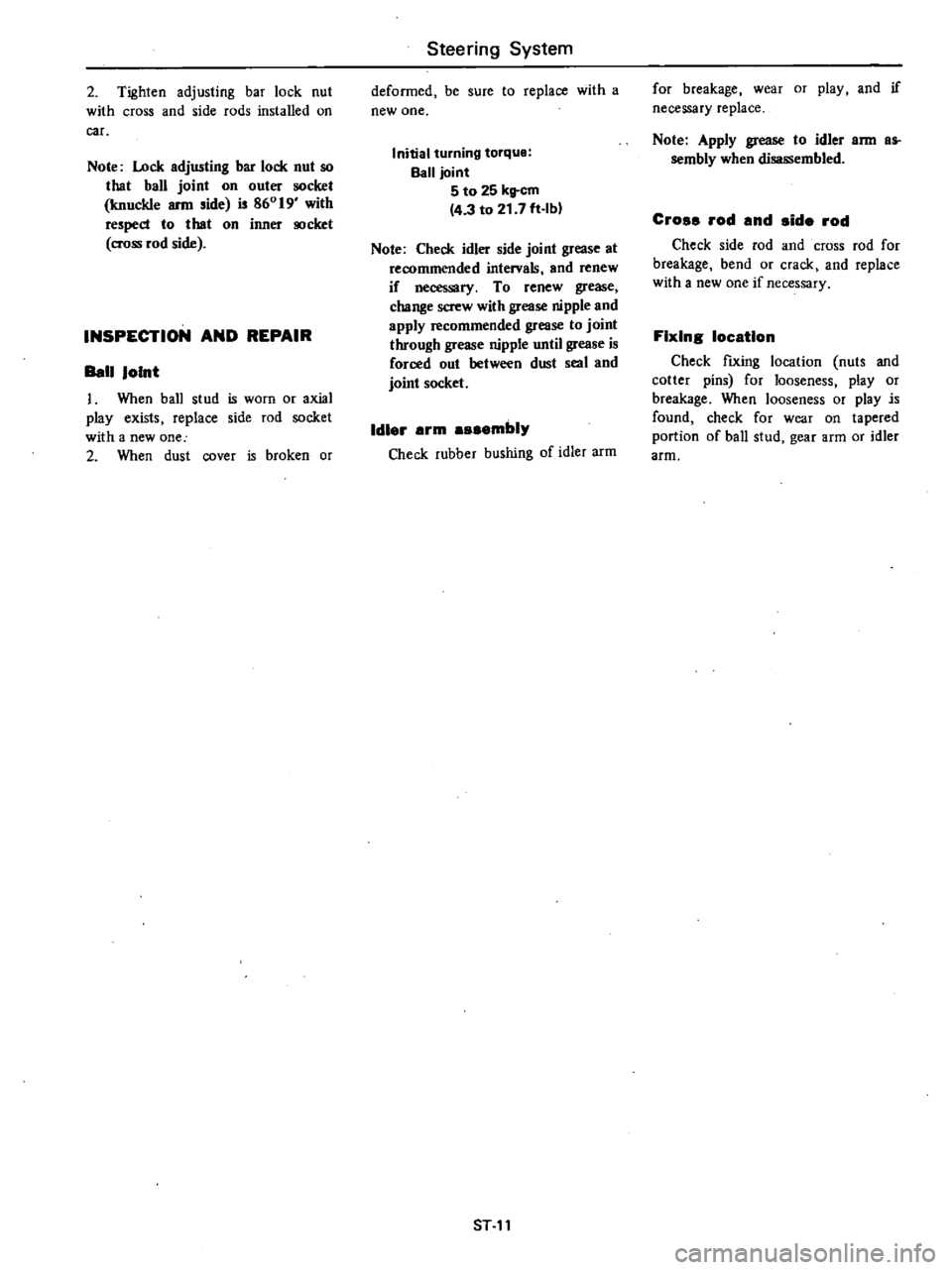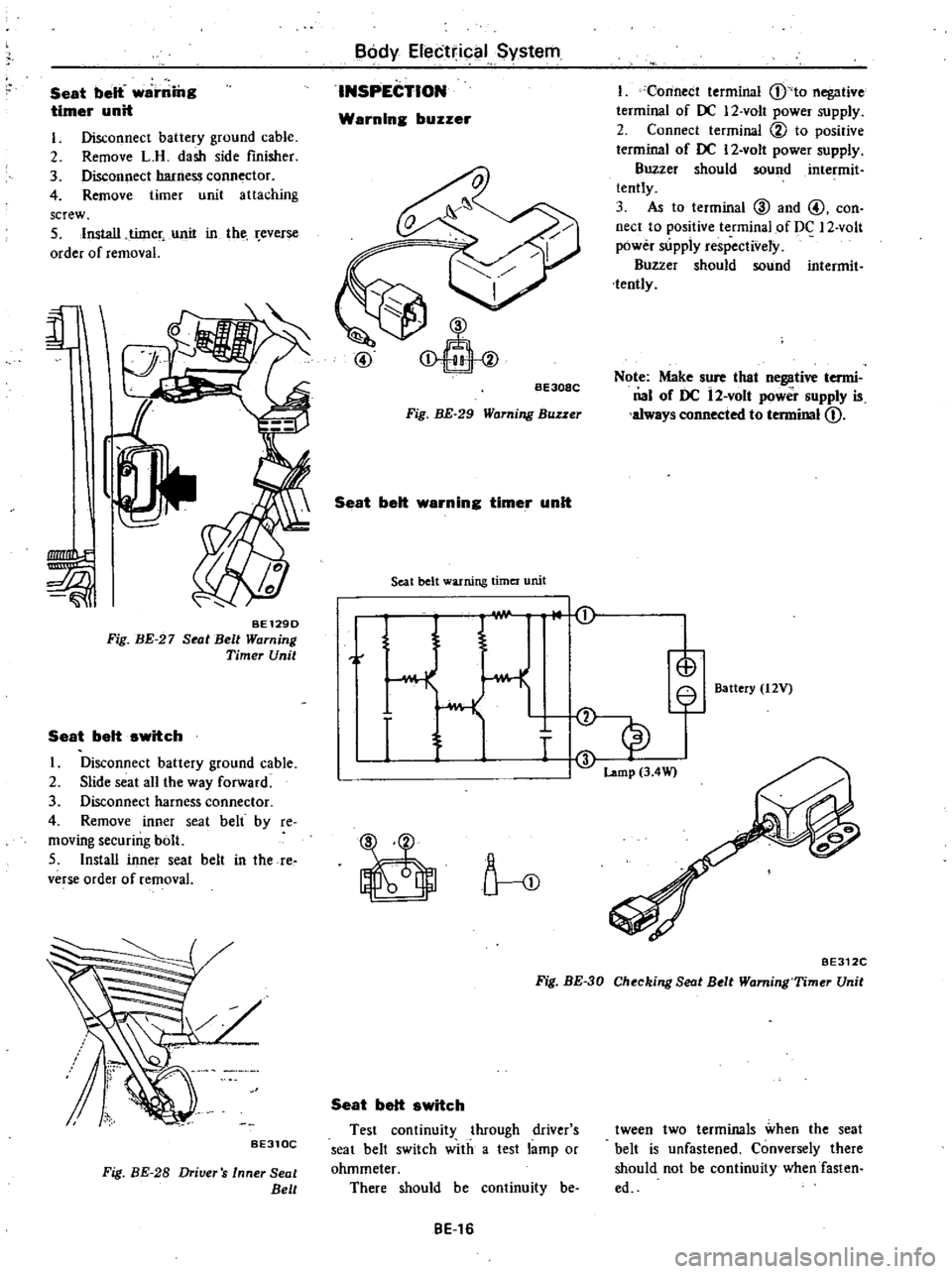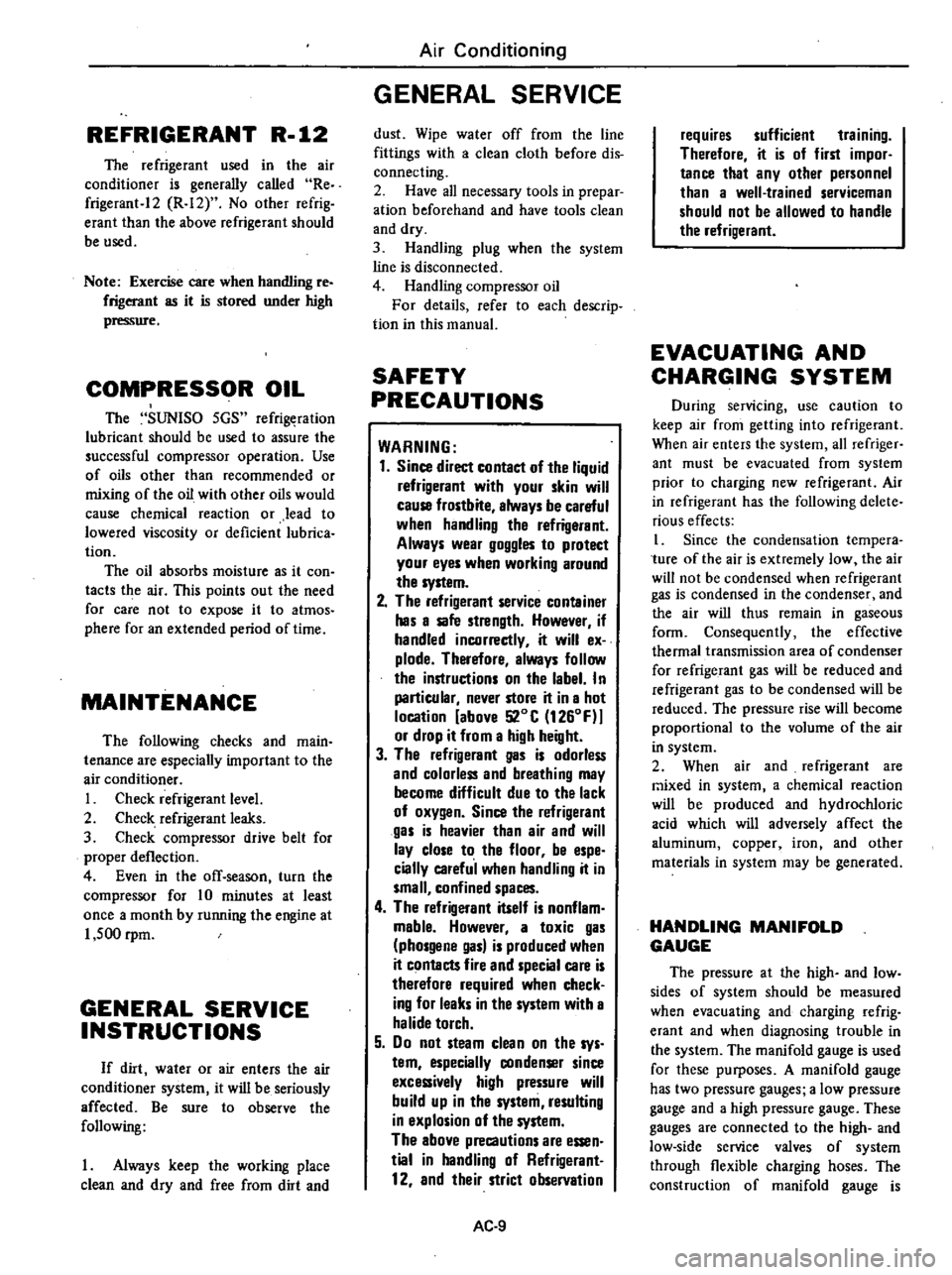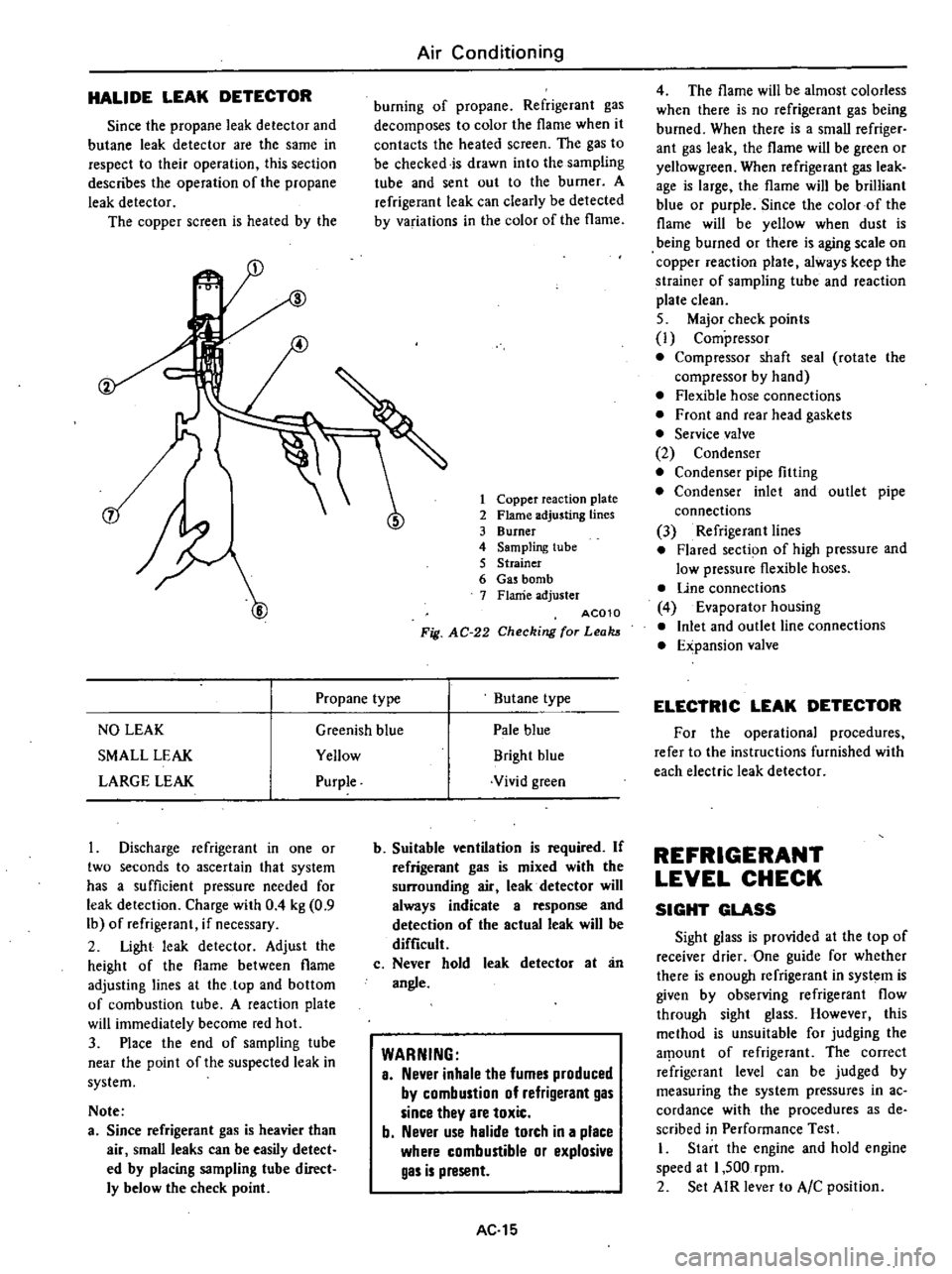ESP DATSUN 210 1979 Owner's Guide
[x] Cancel search | Manufacturer: DATSUN, Model Year: 1979, Model line: 210, Model: DATSUN 210 1979Pages: 548, PDF Size: 28.66 MB
Page 394 of 548

2
Tighten
adjusting
bar
lock
nut
with
cross
and
side
rods
installed
on
car
Note
Lock
adjusting
bar
lock
nut
so
that
ball
joint
on
outer
socket
knuckle
arm
side
is
86019
with
respect
to
that
on
inner
socket
cross
rod
side
INSPECTION
AND
REPAIR
Ball
Joint
1
When
ball
stud
is
worn
or
axial
play
exists
replace
side
rod
socket
with
a
new
one
2
When
dust
cover
is
broken
or
Steering
System
deformed
be
sure
to
replace
with
a
new
one
Initial
turning
torque
Ball
joint
5
to
25
kg
em
4
3
to
21
7
ft
Ibl
Note
Check
idler
side
joint
grease
at
recommended
intervals
and
renew
if
necessary
To
renew
grease
change
screw
with
grease
nipple
and
apply
recommended
grease
to
joint
through
grease
nipple
until
grease
is
forced
out
between
dust
seal
and
joint
socket
Idler
erm
8ssembly
Check
rubber
bushing
of
idler
arm
ST
11
for
breakage
wear
or
play
and
if
necessary
replace
Note
Apply
grease
to
idler
ann
as
sembly
when
disassembled
Cross
rod
and
side
rod
Check
side
rod
and
cross
rod
for
breakage
bend
or
crack
and
replace
with
a
new
one
if
necessary
Fixing
location
Check
fIxing
location
nuts
and
cotter
pins
for
looseness
play
or
breakage
When
looseness
or
play
is
found
check
for
wear
on
tapered
portion
of
ball
stud
gear
arm
or
idler
arm
Page 456 of 548

ILLUMINATION
CONTROL
UNIT
Body
Electrical
System
8
GY
GW
AIMING
ADJUSTMENT
To
adjust
vertical
aim
use
adjusting
screw
on
upper
side
of
headlamp
and
to
adjust
horizontal
ailn
use
adjusting
screw
on
side
of
headlamp
BE1200
Fig
BE
I3
Illumination
Control
Unit
1
Vertical
adjustment
2
Horizontal
adjustment
BE1210
Fig
BE
14
Aiming
Ad
iusting
Screws
Note
Before
makiiIg
headlamp
aim
ing
adjustment
observe
the
follow
ing
instructions
a
Keep
all
tires
inflated
to
correct
pressures
b
Place
car
and
tester
on
one
and
BE
11
same
flat
surface
c
See
that
there
is
no
load
in
car
coolant
engine
oil
fIlled
up
to
correct
level
and
full
fuel
tank
other
than
the
driver
or
equivalent
weight
placed
in
driver
s
position
d
For
details
refer
to
SAE
J599d
When
performing
headlamp
aiming
adjustment
use
an
aiming
machine
aiming
wall
screen
or
headlamp
tester
For
operating
instructions
of
any
almer
it
should
be
in
good
repair
calibrated
and
used
accordi
g
to
respective
operation
manuals
supplied
with
the
unit
If
any
aimer
is
not
available
aiming
adjustment
can
be
done
as
follqws
Turn
headlamp
low
beam
on
H
Horizontal
center
line
of
headlamps
BE297D
Fig
BE
I5
Aiming
Adjustment
Unit
mm
in
Note
a
Adjust
headlamps
so
that
upper
edge
of
hot
spot
is
equal
in
height
to
headlamp
height
and
left
edge
of
hot
spot
is
equal
in
height
to
each
center
line
of
headlamps
b
Dotted
lines
in
illustration
show
center
of
headlamp
Page 461 of 548

Seat
belt
wammg
timer
unit
1
Disconnect
battery
ground
cable
2
Remove
L
A
dash
side
finisher
3
Disconnect
b
arness
conn
ctor
4
Remove
timer
unit
attaching
screw
S
Install
timer
unit
in
the
everse
order
of
removal
BE1290
Fig
BE
27
Seat
Belt
Warning
Timer
Unit
Seat
belt
switch
I
Disconnect
battery
ground
cable
2
Slide
seat
all
the
way
forward
3
Disconnect
harness
connector
4
Remove
inner
seat
belt
by
re
moving
securing
bolt
5
Install
inner
seat
belt
in
the
re
verse
order
of
removal
BE31QC
Fig
BE
28
Driver
s
Inner
Seat
Belt
Body
Electrical
System
INSPECTION
Warning
buzzer
BE308C
Fig
BE
29
Warning
Buzzer
Seat
belt
warning
timer
unit
Seat
belt
warning
timer
unit
I
Y
o
j
r
tIT
I
Connect
terminal
j
to
negative
terminaI
of
DC
12
volt
power
supply
2
Connect
terminal
to
positive
terminal
of
DC
12
volt
power
supply
Buzzer
should
sound
intermit
tent
y
3
As
to
terminal
@
and
@
con
nect
to
positive
terminal
of
DC
12
volt
power
supply
respectively
Buzzer
should
sound
intermit
tently
Note
Make
sure
that
negative
termi
nal
of
DC
12
volt
power
supply
is
a1ways
connected
to
tenninal
CD
Q
e
Battery
t2V
Lamp
3
4W
BE312C
Fig
BE
30
Checking
Seat
Belt
Warning
Timer
Unit
Seat
belt
switch
Test
continuity
through
driver
s
seat
belt
switch
with
a
test
lamp
or
ohmmeter
There
should
be
continuity
be
BE
16
tween
two
terminals
when
the
seat
belt
is
unfastened
Conversely
there
should
not
be
continuity
when
fasten
ed
Page 488 of 548

Speedometer
Condition
Neither
speedometer
pointer
nor
odometer
operates
Unstable
speedometer
pointer
Unusual
sound
occurs
in
response
to
increase
in
driving
speed
Inaccurate
speedometer
indication
Inaccurate
odometer
operation
Body
Electrical
System
Probable
cause
Loose
speedomeTer
cable
union
nut
Broken
speedometer
cable
Damaged
speedometer
drive
pinion
gear
Transmission
side
Faulty
speedometer
Improperly
tightened
or
loose
speedometer
cable
union
nut
Damaged
speedometer
cable
Faulty
speedometer
Excessively
bent
or
twisted
speedometer
cable
inner
wire
or
lack
of
lubrication
Faulty
speedometer
Faulty
speedometer
Improperly
meshed
second
and
third
gear
or
worn
gears
Faulty
feeding
due
to
deformed
odometer
and
pinion
carrier
BE
43
Corrective
action
Retighten
Replace
Replace
Replace
Retighten
Replace
Replace
Replace
or
lubricate
Replace
Replace
Replace
speedometer
Replace
speedometer
Page 510 of 548

REFRIGERANT
R
12
The
refrigerant
used
in
the
air
conditioner
is
generally
called
Re
frigerant
12
R
12
No
other
refrig
erant
than
the
above
refrigerant
should
be
used
Note
Exercise
care
when
handling
re
frigerant
as
it
is
stored
under
high
pressure
COMPRESSOR
OIL
The
SUNISO
5GS
refrig
ration
lubricant
should
be
used
to
assure
the
successful
compressor
operation
Use
of
oils
other
than
recommended
or
mixing
of
the
oil
with
other
oils
would
cause
chemical
reaction
or
lead
to
lowered
viscosity
or
deficient
lubrica
tion
The
oil
absorbs
moisture
as
it
con
tacts
the
air
This
points
out
the
need
for
care
not
to
expose
it
to
atmos
phere
for
an
extended
period
of
time
MAINTENANCE
The
following
checks
and
main
tenance
are
especially
important
to
the
air
conditioner
I
Check
refrigerant
level
2
Check
refrigerant
leaks
3
Check
compressor
drive
belt
for
proper
deflection
4
Even
in
the
off
season
turn
the
compressor
for
10
minutes
at
least
once
a
month
by
running
the
engine
at
1
500
rpm
GENERAL
SERVICE
INSTRUCTIONS
If
dirt
water
or
air
enters
the
air
conditioner
system
it
will
be
seriously
affected
Be
sure
to
observe
the
following
I
Always
keep
the
working
place
clean
and
dry
and
free
from
dirt
and
Air
Conditioning
GENERAL
SERVICE
dust
Wipe
water
off
from
the
line
fittings
with
a
clean
cloth
before
dis
connecting
2
Have
all
necessary
tools
in
prepar
ation
beforehand
and
have
tools
clean
and
dry
3
Handling
plug
when
the
system
line
is
disconnected
4
Handling
compressor
oil
For
details
refer
to
each
descrip
tion
in
this
manual
SAFETY
PRECAUTIONS
WARNING
1
Since
direct
contact
of
the
liquid
refrigerant
with
your
skin
will
cause
frostbite
always
be
carelul
when
handling
the
refrigerant
Always
wear
goggles
to
protect
your
eyes
when
working
around
the
system
2
The
refrigerant
service
container
has
a
safe
strength
However
if
handled
incorrectly
it
will
ex
plode
Therelore
always
follow
the
instructions
On
the
label
In
particular
never
store
it
in
a
hot
location
above
520e
1260F
or
drop
it
from
a
high
height
3
The
refrigerant
gas
is
odorless
and
colorless
and
breathing
may
become
difficult
due
to
the
lack
of
oxygen
Since
the
relrigerant
gas
is
heavier
than
air
and
will
lay
close
to
the
floor
be
espe
cially
careful
when
handling
it
in
small
confined
spaces
4
The
refrigerant
itself
is
nonflam
mable
However
a
toxic
gas
phosgene
gas
is
produced
when
it
contacu
fire
and
special
care
is
therefore
required
when
check
ing
for
leaks
in
the
system
with
a
halide
torch
5
Do
not
steam
clean
On
the
sys
tem
especially
condenser
since
excessively
high
pressure
will
build
up
in
the
system
resulting
in
explosion
of
the
system
The
above
precautions
are
essen
tial
in
handling
of
Refrigerant
12
and
their
strict
observation
AC
9
requires
sufficient
training
Therefore
it
is
of
first
impor
tance
that
any
other
personnel
than
a
well
trained
serviceman
should
not
be
allowed
to
handle
the
refrigerant
EVACUATING
AND
CHARGING
SYSTEM
During
servicing
use
caution
to
keep
air
from
getting
into
refrigerant
When
air
enters
the
system
all
refriger
ant
must
be
evacuated
from
system
prior
to
charging
new
refrigerant
Air
in
refrigerant
has
the
following
delete
rious
effects
1
Since
the
condensation
tempera
ture
of
the
air
is
extremely
low
the
air
will
not
be
condensed
when
refrigerant
gas
is
condensed
in
the
condenser
and
the
air
will
thus
remain
in
gaseous
fonn
Consequently
the
effective
thermal
transmission
area
of
condenser
for
refrigerant
gas
will
be
reduced
and
refrigerant
gas
to
be
condensed
will
be
reduced
The
pressure
rise
will
become
proportional
to
the
volume
of
the
air
in
system
2
When
air
and
refrigerant
are
r
tixed
in
system
a
chemical
reaction
will
be
produced
and
hydrochloric
acid
which
will
adversely
affect
the
aluminum
copper
iron
and
other
materials
in
system
may
be
generated
HANDLING
MANIFOLD
GAUGE
The
pressure
at
the
high
and
low
sides
of
system
should
be
measured
when
evacuating
and
charging
refrig
erant
and
when
diagnosing
trouble
in
the
system
The
manifold
gauge
is
used
for
these
purposes
A
manifold
gauge
has
two
pressure
gauges
a
low
pressure
gauge
and
a
high
pressure
gauge
These
gauges
are
connected
to
the
high
and
low
side
service
valves
of
system
through
flexible
charging
hoses
The
construction
of
manifold
gauge
is
Page 512 of 548

Air
Conditioning
6
Loosen
the
connection
at
the
center
fitting
of
manifold
gauge
for
a
Clockwise
few
seconds
to
purge
air
inside
charg
ing
hose
See
Fig
AC
14
Counterclockwise
j
3
@
I
Can
tap
handle
2
ChlcginS
hose
3
Needle
4
Refrigerant
can
AC246
Fig
AC
13
Can
Top
Purging
air
R
12
To
L9w
pressure
service
valve
AC247
Fig
AC
14
Purging
Air
Ta
High
pressure
service
valve
f
r
AC181A
Fig
AC
15
Discharging
System
AC
ll
DISCHARGING
SYSTEM
The
pressurized
refrigerant
gas
in
side
system
must
be
discharged
to
a
pressure
approaching
atmospheric
pressure
prior
to
evacuating
refrigerant
inside
system
This
operation
should
be
also
made
to
pennit
safe
removal
when
replacing
system
components
A
Close
high
and
low
pressure
valves
of
manifold
gauge
fully
2
Connect
two
charging
hoses
of
manifold
gauge
to
their
respective
service
valves
WARNING
Securely
connect
high
pressure
dis
charge
service
valve
to
that
of
manifold
gauge
with
a
hose
also
connect
low
pressure
suction
serv
ice
valve
to
that
of
manifold
gauge
For
locations
of
high
and
low
pres
sure
discharge
and
suction
service
valves
see
Fig
AC
29
3
Open
both
manifold
gauge
valves
slightly
and
slowly
discharge
refriger
ant
from
system
See
Fig
AC
15
WARNING
Protect
fingers
with
cloth
against
frostbite
by
refrigerant
when
con
necting
the
charging
hose
to
the
service
valve
or
disconnecting
it
therefrom
Nole
Do
not
allow
refrigerant
to
rush
out
Otherwise
compressor
oil
will
be
discharged
along
with
refriger
ant
EVACUATING
SYSTEM
I
Connect
high
and
low
pressure
charging
hoses
of
manifold
gauge
to
their
respective
service
valves
of
sys
tem
and
discharge
refrigerant
from
system
Refer
to
Discharging
System
WARNING
Securely
connect
high
pressure
dis
charge
service
valve
to
that
of
manifold
gauge
with
a
hose
also
connect
low
pressure
suction
servo
ice
valve
to
that
of
manifold
gauge
For
locations
of
high
and
low
pres
sure
discharge
and
wction
service
valves
see
Fig
AC
29
Page 515 of 548

4
Wfefrlgerant
charging
speed
slows
down
charge
it
while
running
the
compressor
for
ease
of
charging
After
having
taken
the
steps
up
to
3
above
proceed
with
charging
in
the
following
order
1
Shut
off
high
pressure
valve
of
manifold
gauge
2
Run
the
engine
at
idling
speeds
below
1
500
rpm
3
Set
the
Temperature
lever
and
Fan
switch
at
maximum
cool
and
maximum
speed
respectively
To
Lpw
pressure
service
valve
t
Air
Conditioning
4
Charge
efiigerani
while
con
trolling
low
pressure
gauge
reading
at
2
8
kg
cm2
40
psi
or
less
by
turning
in
or
out
low
pressure
valve
of
mani
fold
gauge
See
Fig
A
20
WARNING
Never
charge
refrigerant
through
high
pressure
side
discharge
side
of
system
since
this
will
force
re
frigerant
back
into
refrigerant
can
and
can
may
explode
To
High
pressure
service
valve
A
5
When
refrigerant
can
is
empty
fully
close
both
valves
of
manifold
gauge
and
replace
refrigerant
can
with
a
new
ot
e
Before
opening
manifold
gauge
valve
to
charge
refrigerant
from
new
can
be
sure
to
purge
air
from
inside
charging
hose
6
Charge
the
specified
amount
of
refrigerant
into
system
by
weighing
charged
refrigerant
with
scale
Over
charging
wiU
cause
discharge
pressure
to
rise
AC380A
Fig
AC
20
Charging
Refrigeront
Measure
the
amount
of
charged
refrigerant
with
a
scale
Make
a
note
of
the
amount
charged
from
can
AC252
Fig
AC
21
Chorging
Refrigeront
Refrigerant
capacity
Unit
kg
lb
Refrigerarit
Minimum
Maximum
R
12
0
8
1
8
1
0
2
2
AC14
Note
The
p
Ce
of
btibble
hi
sight
glass
of
receiver
drier
is
an
unsuitable
method
of
checking
the
amount
of
refrigerant
charged
in
system
The
state
of
the
bubbles
iJt
sight
glass
should
only
be
used
ior
checking
whether
the
amount
of
charged
refrigerant
is
small
or
not
The
amount
of
charged
refrigerani
can
be
correcdy
judged
by
means
of
discharge
pressure
Refer
to
Re
frigerant
Level
Check
7
After
the
specified
amount
of
refrigerant
has
been
charged
intosys
tern
close
manifold
gauge
valves
Then
detach
charging
hoses
from
service
valves
of
system
Be
sure
to
install
valve
cap
to
service
valve
8
Confirm
that
there
are
no
leaks
in
system
by
checking
with
a
leak
detec
tor
Refer
to
Checking
for
Leaks
Note
Conducting
8
performance
test
prior
to
removing
manifold
gauge
is
8
good
service
operation
Refer
to
Performance
Test
CHECKING
FOR
LEAKS
Conduct
a
leak
t
st
whenever
leak
age
of
refrigerant
is
suspected
and
when
conducting
service
operations
which
are
accompanied
by
disassembly
or
loosening
of
connection
fittings
Refrigerant
is
a
colorless
odorless
gas
and
leakage
from
system
is
diffi
cult
to
detect
Accordingly
the
use
of
a
leak
detector
facilitates
check
for
leaks
Two
methods
of
checking
are
available
one
employs
a
halide
leak
detector
which
bums
propane
gas
or
butane
gas
and
the
other
is
an
electric
type
leak
detector
If
any
trace
of
oil
is
noted
at
and
around
connection
fittings
it
is
a
sure
indication
that
refrigerant
is
leaking
This
condition
can
be
corrected
easily
by
retightening
the
joints
If
any
joint
on
line
is
suspected
of
small
amount
of
leakage
use
a
leak
detector
to
locate
leaking
points
Page 516 of 548

HALIDE
LEAK
DETECTOR
Since
the
propane
leak
detector
and
butane
leak
detector
are
the
same
in
respect
to
their
operation
this
section
describes
the
operation
of
the
propane
leak
detector
The
copper
screen
is
heated
by
the
Air
Conditioning
burning
of
propane
Refrigerant
gas
decomposes
to
color
the
flame
when
it
contacts
the
heated
screen
The
gas
to
be
checked
is
drawn
into
the
sampling
tube
and
sent
out
to
the
burner
A
refrigerant
leak
can
clearly
be
detected
by
variations
in
the
color
of
the
flame
1
Copper
reaction
plate
2
Flame
adjusting
lines
3
Burner
4
Sampling
tube
5
Strainer
6
Gas
bomb
7
Flame
adjuster
AC010
Fig
AC
22
Checking
for
Leaks
4
The
flame
will
be
almost
colorless
when
there
is
no
refrigerant
gas
being
burned
When
there
is
a
small
refriger
ant
gas
leak
the
flame
will
be
green
or
yellowgreen
When
refrigerant
gas
leak
age
is
large
the
flame
will
be
brilliant
blue
or
purple
Since
the
color
of
the
flame
will
be
yellow
when
dust
is
being
burned
or
there
is
aging
scale
on
copper
reaction
plate
always
keep
the
strainer
of
sampling
tube
and
reaction
plate
clean
5
Major
check
points
l
Compressor
Compressor
shaft
seal
rotate
the
compressor
by
hand
Flexible
hose
connections
Front
and
rear
head
gaskets
Service
valve
2
Condenser
Condenser
pipe
fitting
Condenser
inlet
and
outlet
pipe
connections
3
Refrigerant
lines
Flared
section
of
high
pressure
and
low
pressure
flexible
hoses
Une
connections
4
Evaporator
housing
Inlet
and
outlet
line
connections
Expansion
valve
Propane
type
Butane
type
ELECTRIC
LEAK
DETECTOR
NO
LEAK
Greenish
blue
Pale
blue
For
the
operational
procedures
SMALL
LEAK
Yellow
Bright
blue
refer
to
the
instructions
furnished
with
LARGE
LEAK
Purple
Vivid
green
each
electric
leak
detector
Discharge
refrigerant
in
one
or
two
seconds
to
ascertain
that
system
has
a
sufficient
pressure
needed
for
leak
detection
Charge
with
0
4
kg
0
9
Ib
of
refrigeranl
if
necessary
2
Light
leak
detector
Adjust
the
height
of
the
flame
between
flame
adjusting
lines
at
the
top
and
bottom
of
combustion
tube
A
reaction
plate
will
immediately
become
red
hot
3
Place
the
end
of
sampling
tube
near
the
point
of
the
suspected
leak
in
system
Note
a
Since
refrigerant
gas
is
heavier
than
air
small
leaks
can
be
easily
detect
ed
by
placing
sampling
tube
direct
ly
below
the
check
point
b
Suitable
ventilation
is
required
If
refrigerant
gas
is
mixed
with
the
surrounding
air
leak
detector
will
always
indicate
a
response
and
detection
of
the
actual
leak
will
be
difficult
c
Never
hold
leak
detector
at
an
angle
WARNING
a
Never
inhale
the
fumes
produced
by
combustion
of
refrigerant
gas
since
they
are
toxic
b
Never
use
halide
torch
in
a
place
where
combustible
or
explosive
gas
is
present
AC
15
REFRIGERANT
LEVEL
CHECK
SIGHT
GLASS
Sight
glass
is
provided
at
the
top
of
receiver
drier
One
guide
for
whether
there
is
enough
refrigerant
in
syst
m
is
given
by
observing
refrigerant
flow
through
sight
glass
However
this
method
is
unsuitable
for
judging
the
aJTlount
of
refrigerant
The
correct
refrigeranl
level
can
be
judged
by
measuring
the
system
pressures
in
ac
cordance
with
the
procedures
as
de
scribed
in
Performance
Test
1
Start
the
engine
and
hold
engine
speed
al
1
500
rpm
2
Set
AIR
lever
to
AlC
position